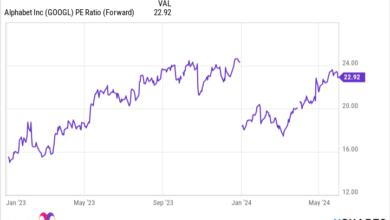Forget Nvidia: These 3 Artificial Intelligence (AI) Stocks Have Between 115% and 127% Upside, According to Select Wall Street Analysts

Move over, Nvidia! These fast-paced artificial intelligence (AI) stocks can more-than-double in value, based on the Street-high price targets of three analysts.
For more than a year, no investment trend on Wall Street has captivated investors’ attention quite like artificial intelligence (AI). Utilizing software and systems in place of humans, and giving these systems the ability to learn over time without human intervention in order to become more proficient at their tasks, gives AI a use case in almost every sector and industry.
Although dozens of stocks have benefited from the investing euphoria associated with AI, no company has enjoyed a more direct boost to its sales and profits than semiconductor giant Nvidia (NVDA -3.87%).
Image source: Getty Images.
Nvidia has taken the AI movement by storm
Nvidia’s infrastructure has quickly become the “brains” that power AI-accelerated data centers. The company’s A100 and H100 graphics processing units (GPUs) are in exceptionally high demand, with the latter responsible for training large language models and powering generative AI solutions.
Further, Nvidia finds itself in an enviable position where demand for its GPUs has completely overwhelmed supply. When the supply of an in-demand good is limited, the price of that good will rise until demand tapers. In fiscal 2024 (ended Jan. 28, 2024), most of the 217% sales growth Nvidia recognized from its data center segment was the result of substantially higher prices on its top-tier GPUs.
There’s also plenty of excitement following the introduction of its next-generation GPU, known as Blackwell. This new GPU promises accelerated computing capabilities that can power everything from generative AI solutions to quantum computing.
The near-term catalysts for Nvidia have been tangible — and this isn’t a fact that’s lost on Wall Street. Analyst Hans Mosesmann of Rosenblatt holds the Street’s highest price target on Nvidia at $1,400 per share. If accurate, Mosesmann’s lofty price target implies nearly 59% upside.
But there are a number of headwinds Nvidia is also contending with. For instance, upping its own production will reduce GPU scarcity and cannibalize its pricing power over time. Further, its top four customers are all developing their own in-house GPUs, which probably means we’re witnessing a peak in orders from these “Magnificent Seven” constituents.
Despite Mosesmann’s cheery forecast for Nvidia, three other AI stocks offer considerably more upside, according to select Wall Street analysts.
Image source: Getty Images.
Baidu: Implied upside of 115%
The first AI stock that could effectively double up Nvidia’s returns, at least based on the prognostication of one Wall Street analyst, is China-based Baidu (BIDU -1.78%). Benchmark analyst Fawne Jiang has, on a couple of occasions, reiterated their price target of $210 for shares of Baidu. Based on its $97.54 closing price on April 12, this suggests up to 115% upside awaits.
One of the lures of Baidu from an investment standpoint is that it has a foundational operating model that would continue generating boatloads of operating cash flow if and when the AI bubbles bursts. Historically speaking, every next-big-thing investment over the last 30 years has worked its way through an early stage bubble, and AI is unlikely to break this trend.
Baidu’s cash-cow segment is its internet search engine. In March, Baidu’s search engine gobbled up a 60.44% market share in China, according to data from GlobalStats. Looking back over the last nine years, it’s predominantly maintained between a 60% and 85% share of domestic internet search in the world’s No. 2 economy by gross domestic product. This makes Baidu the logical choice for merchants wanting to get their message in front of consumers.
For the time being, Baidu has two key AI drivers: its AI cloud segment and its intelligent driving unit. Baidu’s AI Cloud is one of the four largest cloud infrastructure service platforms in China. Since enterprise spending on cloud services is still in its early innings, this bodes well for sustained double-digit growth.
Meanwhile, subsidiary Apollo Go is the most-successful autonomous ride-hailing service on the planet. As of Jan. 2, 2024, Apollo Go had surpassed 5 million autonomous rides since its inception.
Baidu is flush with cash (over $28 billion in cash, cash equivalents, and various investments), and it’s valued at a historically cheap 8 times forward-year earnings. Long story short, Jiang’s price target isn’t unreasonable.
Mobileye Global: Implied upside of 127%
A second artificial intelligence stock that could run circles around Nvidia in the return department is the developer of advanced driver assistance systems (ADAS) and various autonomous driving solutions, Mobileye Global (MBLY 2.75%). Citigroup analyst Itay Michaeli believes shares of the company will head to $72, which would result in a 127% increase, relative to where shares closed on April 12.
Whereas a significant percentage of Baidu’s cash flow is insulated in the event that the AI bubble bursts, Mobileye is highly dependent on a strong U.S. economy and AI continuing to its drive sales growth.
Since the company’s ADAS and autonomous driving solutions are found in next-generation vehicles, and these vehicles are progressively becoming more reliant on technology, the health of the auto market is paramount to its success. Unfortunately for Mobileye Global, demand for electric vehicles (EVs) has been fading domestically, to the point where legacy titans like General Motors and Ford Motor Company have scaled back their EV production ramp.
If there are silver linings to be found, it’s that Mobileye is profitable on a recurring basis, generating plenty of operating cash flow, and closed out 2023 with approximately $1.2 billion in cash and no debt. It has the capital to continue innovating in any economic climate, and it benefits from the fact that periods of growth in the U.S. and global economy last significantly longer than contractions and recessions.
Although Mobileye Global looks to have a bright future, it has a long way to go if it’s to grow into a $72-per-share valuation, which would represent a $58 billion market cap.
SoundHound AI: Implied upside of 117%
The third artificial intelligence stock that has the ability to handily outpace Nvidia to the upside, based on the projections of one Wall Street analyst, is voice-recognition software company SoundHound AI (SOUN -2.46%). Last month, D.A. Davidson analyst Gil Luria raised his price target on SoundHound to $9.50 per share, which currently implies upside of 117%, based on where shares of the company ended on April 12.
The excitement surrounding small-cap AI stock SoundHound really kicked in mid-February, which is when Form 13Fs were filed with the Securities and Exchange Commission.
Traditionally, a 13F provides a detailed snapshot of what Wall Street’s top money managers have been buying and selling in the latest quarter. But in this instance, Nvidia’s 13F revealed that it had purchased 1,730,883 shares of SoundHound AI, worth about $3.67 million, during the December-ended quarter. When the infrastructure backbone of the AI revolution is buying shares of a relatively unknown AI up-and-comer, you pay attention!
Quite a few of the Magnificent Seven members have been investing aggressively in voice-driven AI assistants. This incudes Amazon‘s Alexa, Apple‘s Siri, and Alphabet‘s Google Assistant, to name a few. During the fourth quarter, sales for SoundHound surged 80%, with full-year revenue jumping 47% to $45.9 million in 2023. Though SoundHound is still just scraping the tip of the iceberg in terms of voice-recognition potential, its sales growth looks to be accelerating.
For the time being, the lion’s share of SoundHound’s revenue can be traced to royalties earned when a vehicle, restaurant, or television utilizes its AI-driven voice-recognition software. Over time, the company anticipates subscriptions will account for a greater percentage of its sales, and more than likely provide a boost to its operating margin.
But in spite of its impressive sales growth, SoundHound AI still lost nearly $89 million last year and burned through $68.3 million in cash via its operations. In short, it’s nowhere close to generating a profit. Until that happens, Luria’s lofty price target is unlikely to be reached.



